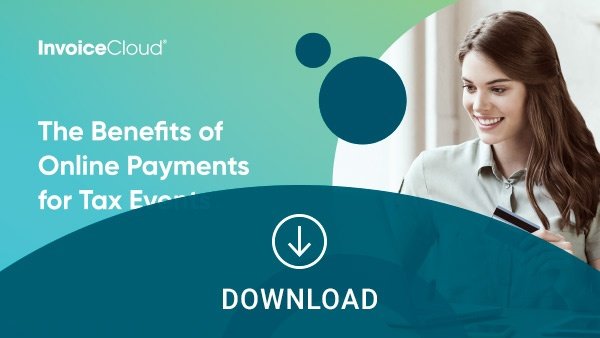4 Ways Your Organization Can Drive Online Payment Adoption for Taxes
 Patty Melton
Patty Melton

When we talk about “adoption,” we are generally referring to electronic billing and payment adoption or the process of driving customers to make payments online. Online payment adoption for taxes, then, is the process of encourage customers (taxpayers) to use a tax organization’s online platform to make (and/or receive) their tax payments.
While this might sound simple and straightforward, it’s anything but. Many online payment platforms offer clunky or difficult-to-use customer interfaces that deter customers from paying their bills online — this often creates added work for internal staff members and encourages late or delinquent payments.
Let’s explore the major benefits of driving online adoption for tax payments and offer a few ways tax organizations like yours can boost adoption to achieve some of your major goals.
Why is adoption important for tax organizations?
Simply put: the more customers who use your organization’s online platform to pay their bills, the less time your staff needs to spend on each of these items.
Here are just a few ways increased online payment adoption translates to positive business results:
Earlier collections during tax events
When customers use online payment channels to make their tax payments, the amount of time that needs to be spent manually collecting and processing those payments is greatly reduced. Beyond smoother, faster collections internally, offering and easy-to-use online payment platform means customers are more likely to make their tax payments earlier in a tax event. This greatly helps to prevent a massive influx of payments on the payment due date and significantly reduces delinquent payments.
Cost savings
Online payment adoption doesn’t just mean encouraging customers to make online payments, it also refers to encouraging customers to enroll in self-service routes like paperless billing or automatic payments (AutoPay). Increased enrollment in services like paperless billing — or spikes in general online payment adoption — translates to real cost savings in the form of decreased print and mailing costs.
Decreased call volumes and staff workloads
For those who mail their own bills, fewer paper bills also means less time spent stuffing and mailing envelopes. With online bill payment, your staff also spends significantly less time processing manual checks. This means your staff can spend more time on higher priority projects, and more time communicating with customers to improve satisfaction and service levels.
Plus, an easy enrollment and payment process means less time that your customer service staff needs to spend resolving customer payment issues, significantly reducing your organization’s call volumes.
Increased customer satisfaction
When an online payment platform makes it simple for customers to adopt online payments and enroll in services like paperless billing, it removes many friction points for your customer. This increased ability for customers to self-serve ultimately improves the customer experience and leaves your organization with happier constituents.
How to drive higher online payment adoption for taxes
Once you understand the important benefits online adoption can offer, your next question may be: how can my organization drive higher online adoption for tax payments?
The key is finding an online payment solution that has been designed to make taxpayers aware of their online payment options and encourage them to enroll at every possible customer engagement point.
If you’re wondering what a well-designed online payment platform looks like, here are the main factors you should look for in a payment solution that will effectively drive adoption:
Simple processes
It shouldn’t be difficult for your customers to use electronic services or enroll in paperless billing. For example, registration for electronic services shouldn’t be required, as many customers are reluctant to create usernames and passwords, at least until those services are proven through experience.
Beyond that, it should be simple and easy to make a payment — regardless of whether someone has registered or set up a payment profile. Creating gates like login screens or registration pages impedes the payment process and makes for a poor customer experience. The easier it is for your customers to make a payment online, the higher the adoption.
Mirroring the paper bill experience
Many customer don’t want their new, e-billing experience to differ from receiving a paper bill. That’s why bill presentment is such an important part of a good online payment platform. Customers should be able to easily see a replica of their paper bill without logging in, registering, or having to download a file, and the online bill should be clearly branded so customers know exactly what they’re paying.
Payment options
Your customers are constantly on the go and want to be able to make bill payments the same way they make other purchases — anytime, anywhere. That’s why the customer payment experience needs to be available across all channels, whether that’s a web payment portal, a mobile payment option, an Interactive Voice Response (IVR) system, or a pay by text functionality. The more online payment options you provide to your customers, the higher the adoption will be. For example, many customers who are reluctant to pay online are perfectly happy to pay by phone using an IVR option.
Most importantly, the customer experience should be the same across all payment channels — meaning that a customer can interact with any channel you have in place and expect the same level of simplicity and ease of use.
Security and compliance
When it comes to making payments online, your customers want to know that their data and payment information is secure. That’s why, when choosing an online payment platform, you’ll want to confirm that your potential software providers follow the applicable requirements set forth in PCI-DSS for security tests, which are typically conducted by an outside testing firm. Make sure any considered providers maintain annual security certifications, like SOC 1 and SOC 2 Type 2, and PCI-DSS Level 1 Service Provider certifications. These verify that the payment platform has implemented effective controls around data security.
How InvoiceCloud can help
InvoiceCloud’s complete, secure online payment solution drives an average increase of 59% in e-adoption and a 2.8x paperless increase. To learn more, schedule a no-obligation call with one of our adoption experts.
Want to learn more about how to online payments can make your tax events easier than ever? Download our free ebook, The Benefits of Online Payments for Tax Events, to keeping reading.



